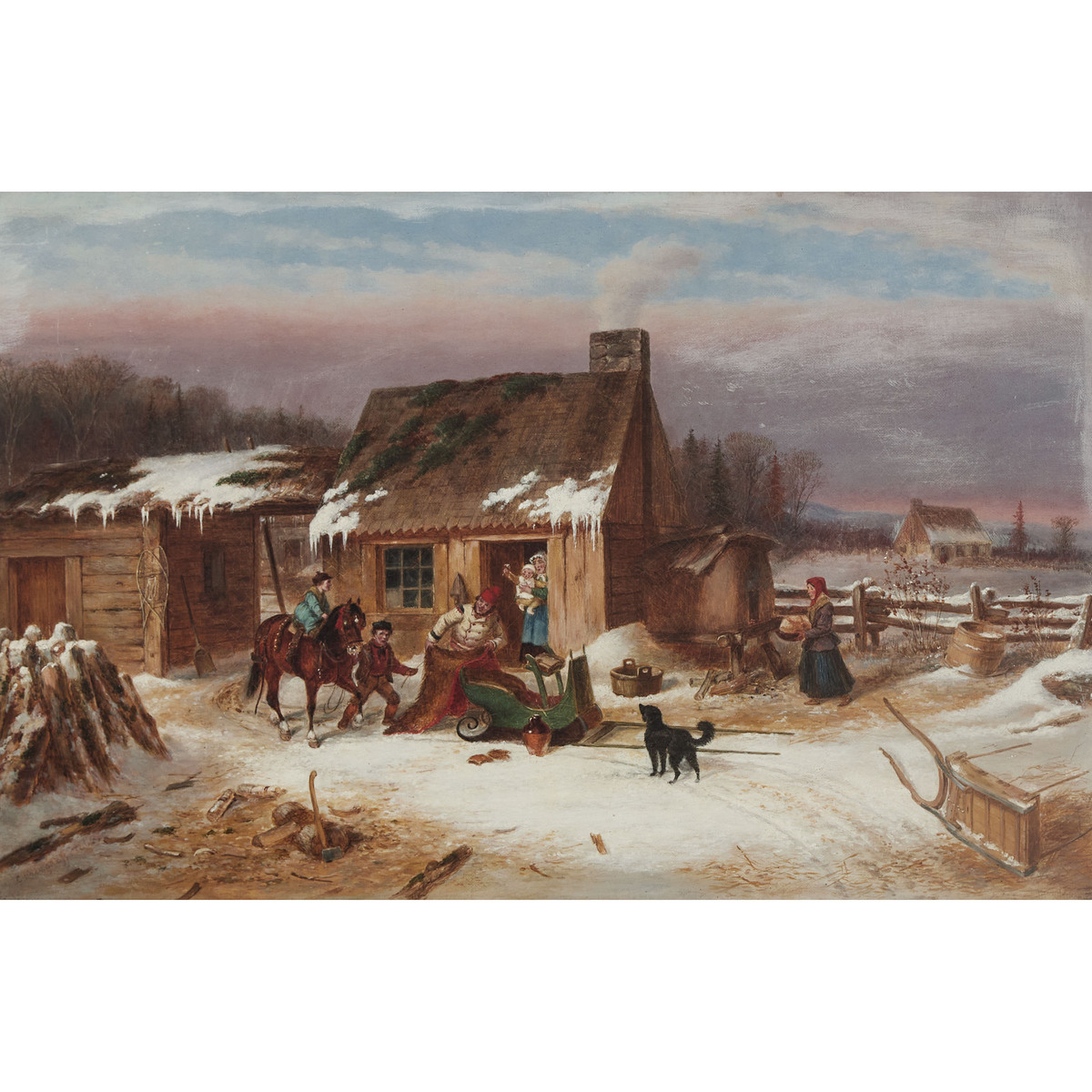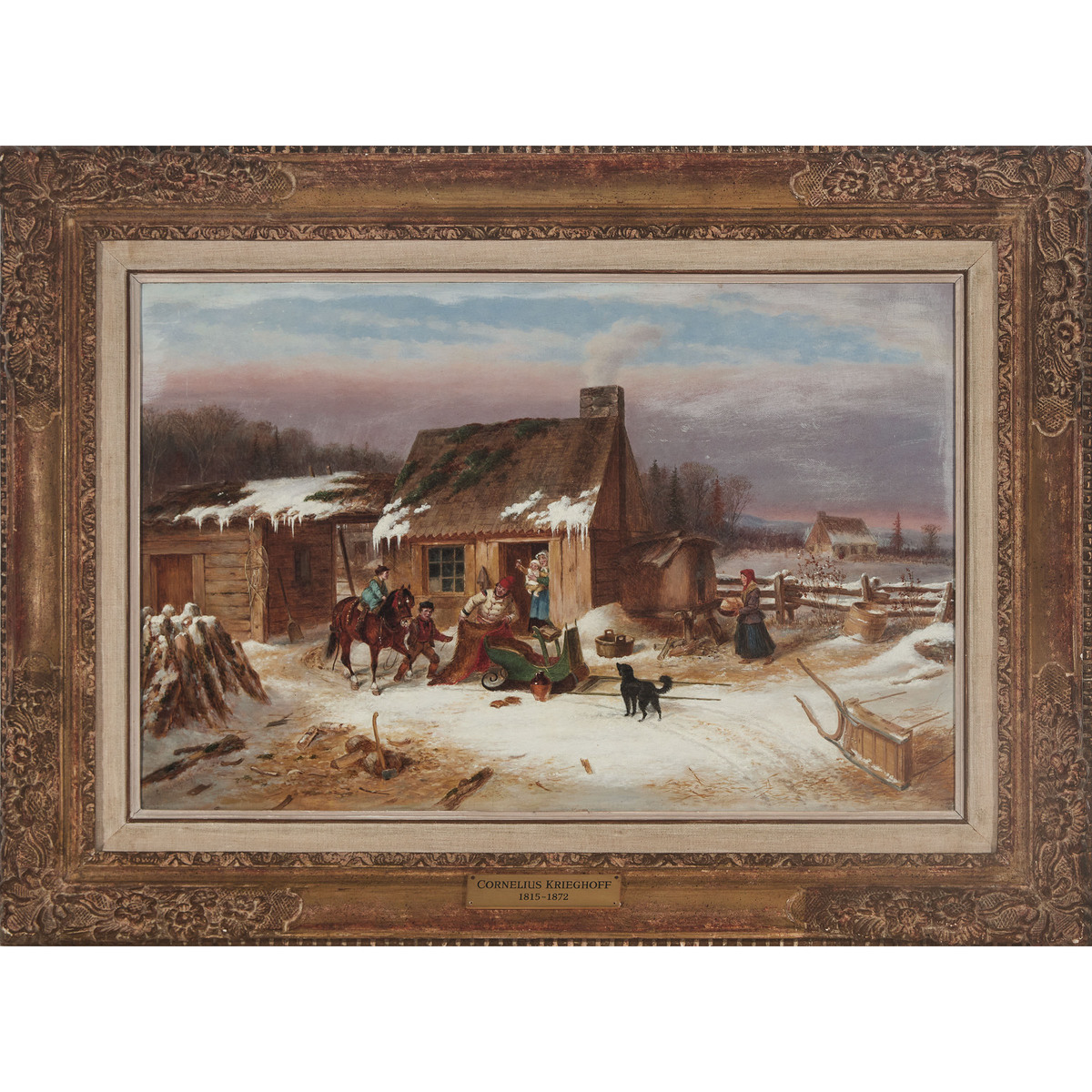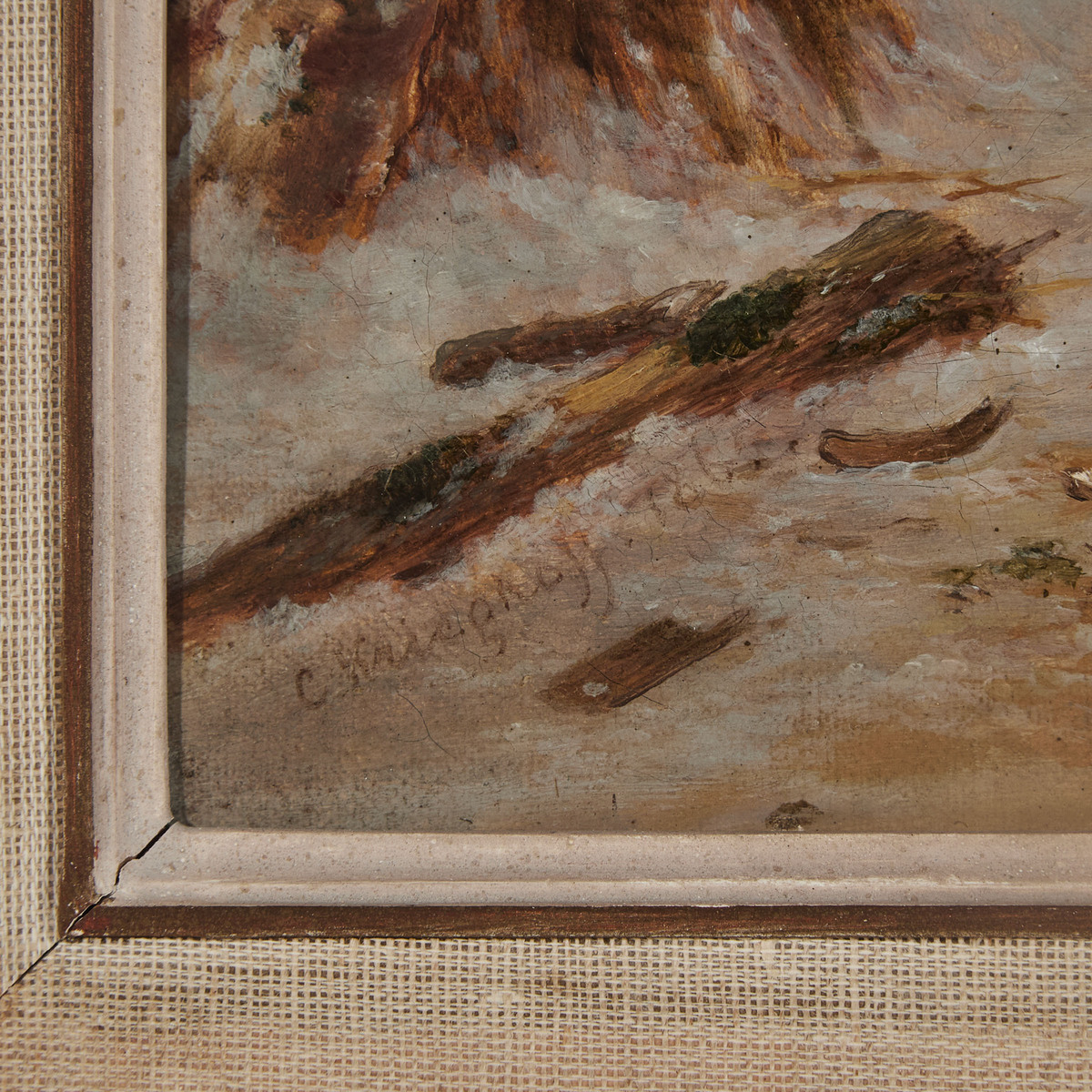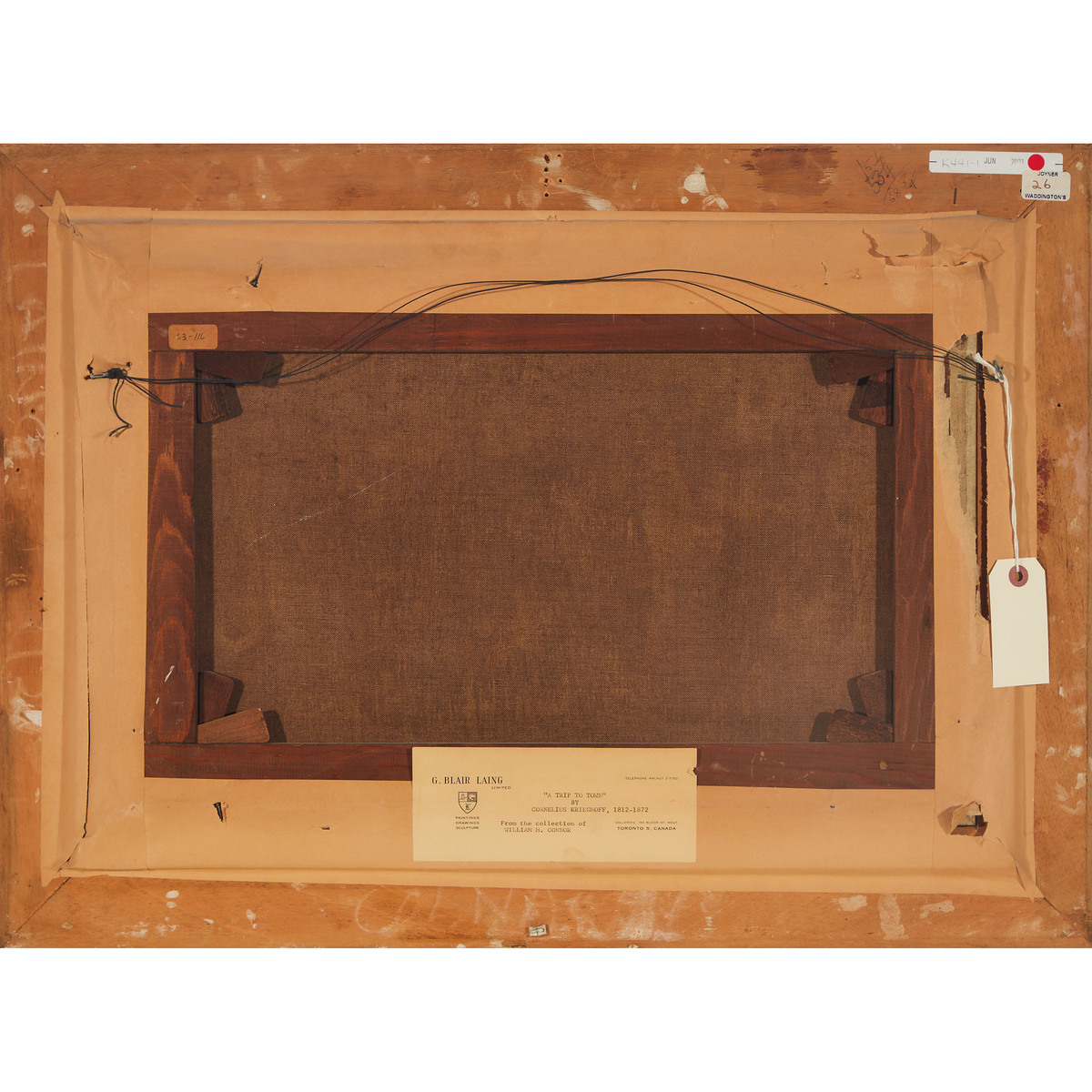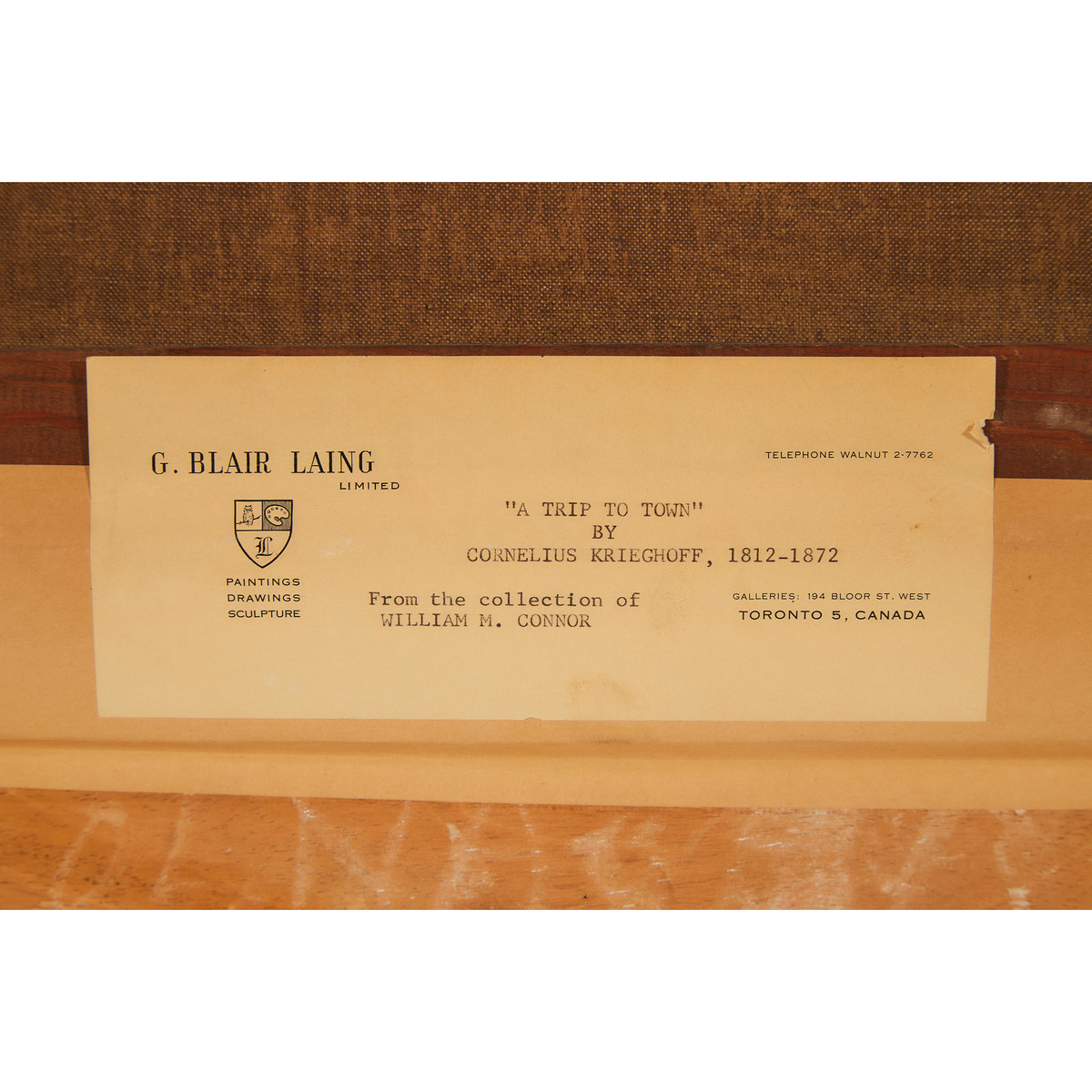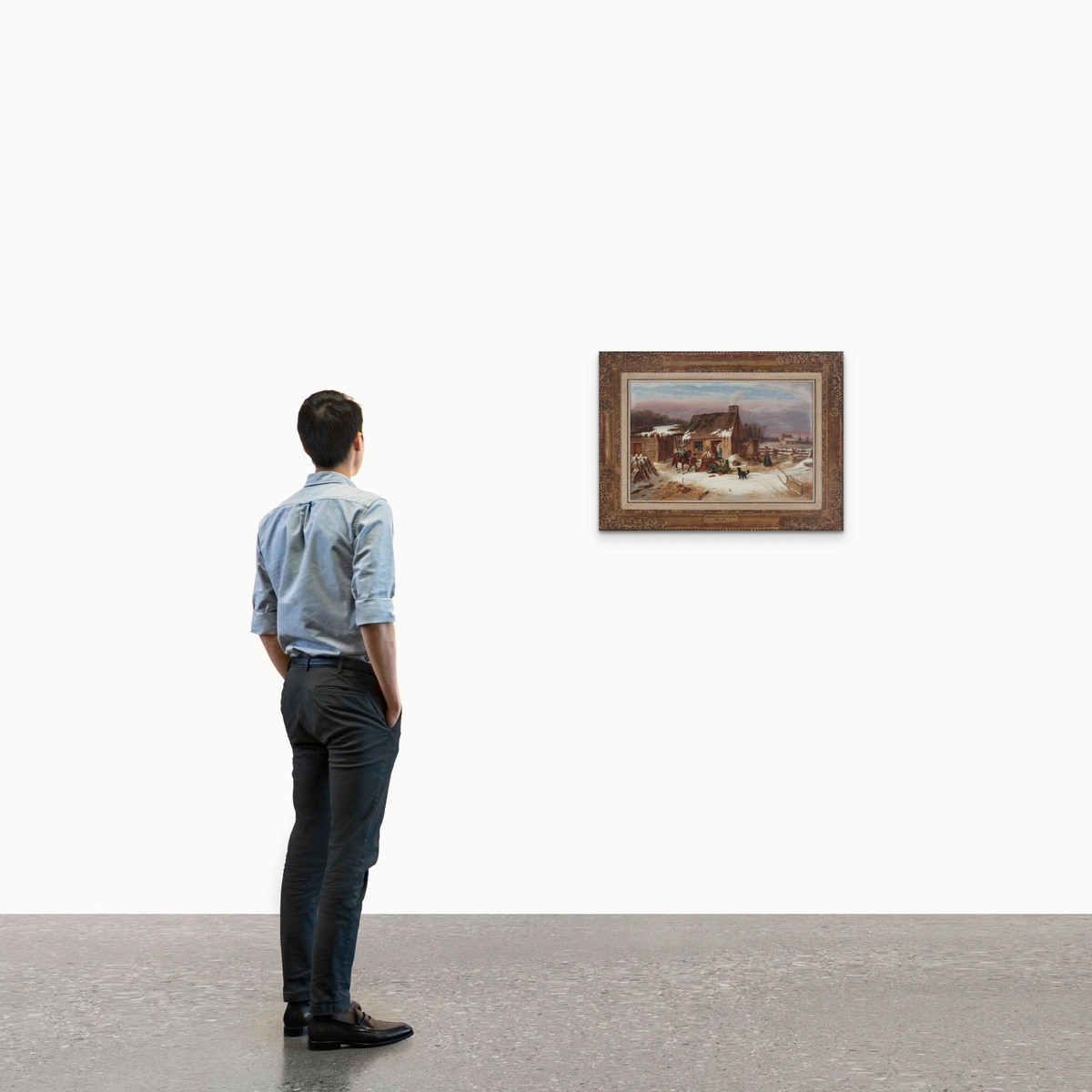30
Cornelius David Krieghoff (1815-1872), A TRIP TO TOWN, 1865, oil on canvas, 14.5 x 22 in — 35.6 x 55
A TRIP TO TOWN, 1865
oil on canvas
signed and indistinctly dated "1865"
14.5 x 22 in — 35.6 x 55.9 cm
Provenance:
Collection of William M. Connor;
G. Blair Laing Limited, Toronto, ON;
Private Collection, Toronto, ON;
Joyner Waddington's, Toronto, ON, 3 Jun 2003, lot 26, as Preparing for a Trip to Town;
Collection of Sir Christopher and Lady Ondaatje
Note:
The habitant subject was one that Krieghoff would return to periodically throughout his career. Unlike some of his earlier and more raucous scenes, later depictions of the rural family, per Dennis Reid, are “not simply represented as a compatible grouping but as though it were a well-trained troupe.” (1) In A Trip to Town, we see father and sons in the act of hitching a well-fed horse to a well-made green cariole, as the kerchiefed mother and her chubby baby observe from the warmth of the house. Another woman brings bread from the outdoor bake-oven, perhaps for sale in town. Clearly, the family prospers.
So little is known about Krieghoff’s educational background, it is impossible to speculate as to what interested him about the lives of ordinary Canadians. Ramsay Cook suggests a few reasons: firstly, that Krieghoff might have been drawn to that which made Canada unique, or secondly, that he was able to carve out a market for these scenes among the soldiers stationed in Quebec who were looking for place-specific souvenirs. A third possibility is that Krieghoff was drawing on the Dutch genre scene. Cook notes that Krieghoff’s Dutch-German heritage would have likely exposed him to Dutch genre scenes, which had been central to the visual culture of Holland since the 17th century. His travels around America would have increased the likelihood of him personally studying genre paintings at length. Cook writes that “what is certain is that genre painting was the style that Krieghoff introduced to Canada in the 1840s and would practise with such success throughout his career.” (3)
Unlike his contemporaries including Antoine Plamondon, Théophile Hamel or Joseph Légaré, Krieghoff tended towards the quotidian subjects which were mostly overlooked. Per Cook, “Krieghoff had a different goal: to portray the human condition, not to elevate his viewers above it. Indeed, his pictures often seem designed to make the viewer part of the incident depicted, to bring the viewer inside the picture. That, according to the nineteenth-century French critic Eugène Fromentin, was the great achievement of Dutch art and what distinguished it from the French academic tradition…The more closely these works are examined, the more convincingly they reveal this outsider's success in drawing his viewers inside part of the world that was nineteenth-century French Canada. Krieghoff saw what he painted; then he transformed it into art.” (3)
(1) Dennis Reid, Krieghoff: Images of Canada, (Toronto: Douglas & McIntyre, 1999), 85.
(2) Ramsay Cook, “The Outsider as Insider: Cornelius Krieghoff's Art of Describing”, Krieghoff Images of Canada, ed. Dennis Reid (Toronto: Douglas & McIntyre, 1999), 155-156.
(3) Cook, 163
Estimate: $100,000—150,000
A TRIP TO TOWN, 1865
oil on canvas
signed and indistinctly dated "1865"
14.5 x 22 in — 35.6 x 55.9 cm
Provenance:
Collection of William M. Connor;
G. Blair Laing Limited, Toronto, ON;
Private Collection, Toronto, ON;
Joyner Waddington's, Toronto, ON, 3 Jun 2003, lot 26, as Preparing for a Trip to Town;
Collection of Sir Christopher and Lady Ondaatje
Note:
The habitant subject was one that Krieghoff would return to periodically throughout his career. Unlike some of his earlier and more raucous scenes, later depictions of the rural family, per Dennis Reid, are “not simply represented as a compatible grouping but as though it were a well-trained troupe.” (1) In A Trip to Town, we see father and sons in the act of hitching a well-fed horse to a well-made green cariole, as the kerchiefed mother and her chubby baby observe from the warmth of the house. Another woman brings bread from the outdoor bake-oven, perhaps for sale in town. Clearly, the family prospers.
So little is known about Krieghoff’s educational background, it is impossible to speculate as to what interested him about the lives of ordinary Canadians. Ramsay Cook suggests a few reasons: firstly, that Krieghoff might have been drawn to that which made Canada unique, or secondly, that he was able to carve out a market for these scenes among the soldiers stationed in Quebec who were looking for place-specific souvenirs. A third possibility is that Krieghoff was drawing on the Dutch genre scene. Cook notes that Krieghoff’s Dutch-German heritage would have likely exposed him to Dutch genre scenes, which had been central to the visual culture of Holland since the 17th century. His travels around America would have increased the likelihood of him personally studying genre paintings at length. Cook writes that “what is certain is that genre painting was the style that Krieghoff introduced to Canada in the 1840s and would practise with such success throughout his career.” (3)
Unlike his contemporaries including Antoine Plamondon, Théophile Hamel or Joseph Légaré, Krieghoff tended towards the quotidian subjects which were mostly overlooked. Per Cook, “Krieghoff had a different goal: to portray the human condition, not to elevate his viewers above it. Indeed, his pictures often seem designed to make the viewer part of the incident depicted, to bring the viewer inside the picture. That, according to the nineteenth-century French critic Eugène Fromentin, was the great achievement of Dutch art and what distinguished it from the French academic tradition…The more closely these works are examined, the more convincingly they reveal this outsider's success in drawing his viewers inside part of the world that was nineteenth-century French Canada. Krieghoff saw what he painted; then he transformed it into art.” (3)
(1) Dennis Reid, Krieghoff: Images of Canada, (Toronto: Douglas & McIntyre, 1999), 85.
(2) Ramsay Cook, “The Outsider as Insider: Cornelius Krieghoff's Art of Describing”, Krieghoff Images of Canada, ed. Dennis Reid (Toronto: Douglas & McIntyre, 1999), 155-156.
(3) Cook, 163
Estimate: $100,000—150,000
Canadian, International, and Inuit Art
Ends from
Venue Address
For Waddington's delivery information please telephone +1 4165049100.
Important Information
Bidding for this sale will take place entirely online on Waddingtons Online Auction Platform
Waddington’s charges a buyer’s premium of 23% on the hammer price up to and including $25,000 CAD. Hammer prices in excess of $25,000 CAD will be charged a buyer’s premium of 20%. Payment for purchases is accepted in Canadian dollars by cash, certified cheque drawn on a Canadian bank, travelers cheque, bank draft or transfer, Visa or Mastercard within 10 days from the date of the sale.
Terms & Conditions
Terms and conditions:
1. All lots are sold “AS IS”. Any description issued by the auctioneer of an article to be sold is subject to variation to be posted or announced verbally in the auction room prior to the time of sale. While the auctioneer has endeavoured not to mislead in the description issued, and the utmost care is taken to ensure the correct cataloguing of each item, such descriptions are purely statements of opinion and are not intended to constitute a representation to the prospective purchasers and no warranty of the correctness of such description is made. An opportunity for inspection of each article is offered prior to the time of sale. No sale will be set aside on account of lack of correspondence of the article with its description or its reproduction, if any, whether colour or black & white. Some lots are of an age and/or nature which preclude their being in pristine condition and some catalogue descriptions make reference to damage and/or restoration. The lack of such a reference does not imply that a lot is free from defects nor does any reference to certain defects imply the absence of others. Frames on artwork are not included as part of purchase or condition. It is the responsibility of prospective purchasers to inspect or have inspected each lot upon which they wish to bid, relying upon their own advisers, and to bid accordingly.
2. Each lot sold is subject to a premium as part of the purchase price as per below:
Live and Online Auctions
(excluding Canadian Fine Art, Inuit Art, The Art of Canada and Fine Wine & Spirits Auctions)













